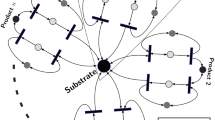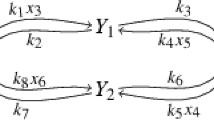Abstract
For dynamical systems arising from chemical reaction networks, persistence is the property that each species concentration remains positively bounded away from zero, as long as species concentrations were all positive in the beginning. We describe two graphical procedures for simplifying reaction networks without breaking known necessary or sufficient conditions for persistence, by iteratively removing so-called intermediates and catalysts from the network. The procedures are easy to apply and, in many cases, lead to highly simplified network structures, such as monomolecular networks. For specific classes of reaction networks, we show that these conditions for persistence are equivalent to one another. Furthermore, they can also be characterized by easily checkable strong connectivity properties of a related graph. In particular, this is the case for (conservative) monomolecular networks, as well as cascades of a large class of post-translational modification systems (of which the MAPK cascade and the n-site futile cycle are prominent examples). Since one of the aforementioned sufficient conditions for persistence precludes the existence of boundary steady states, our method also provides a graphical tool to check for that.
Similar content being viewed by others
References
Amann H (1990) Ordinary differential equations: an introduction to nonlinear analysis. De Gruyter studies in mathematics. de Gruyter, Berlin
Anderson DF (2008) Global asymptotic stability for a class of nonlinear chemical equations. SIAM J Appl Math 68(5):1464–1476
Anderson DF (2011) A proof of the global attractor conjecture in the single linkage class case. SIAM J Appl Math 71(4):1487–1508
Angeli D, De Leenheer P, Sontag ED (2007) A Petri net approach to the study of persistence in chemical reaction networks. Math Biosci 210(2):598–618
Angeli D, De Leenheer P, Sontag ED (2010) Graph-theoretic characterizations of monotonicity of chemical networks in reaction coordinates. J Math Biol 61(4):581–616
Angeli D, De Leenheer P, Sontag ED (2011) Persistence results for chemical reaction networks with time-dependent kinetics and no global conservation laws. SIAM J Appl Math 71(1):128–146
Cordone R, Ferrarini L, Piroddi L (2005) Enumeration algorithms for minimal siphons in petri nets based on place constraints. IEEE Trans Syst Man Cybern Part A Syst Hum 35(6):844–854
Craciun G, Nazarov F, Pantea C (2013) Persistence and permanence of mass-action and power-law dynamical systems. SIAM J Appl Math 73(1):305–329
Deshpande A, Gopalkrishnan M (2014) Autocatalysis in reaction networks. Bull Math Biol 76(10):2570–2595
Feinberg M (1995) The existence and uniqueness of steady states for a class of chemical reaction networks. Arch Rational Mech Anal 132(4):311–370
Feinberg M (1980) Lectures on chemical reaction networks. Notes of lectures given at the Mathematics Research Centre, University of Wisconsin-Madison, in the autumn of 1979. http://www.crnt.osu.edu/LecturesOnReactionNetworks
Feinberg M (1987) Chemical reaction network structure and the stability of complex isothermal reactorsi. the deficiency zero and deficiency one theorems. Chem Eng Sci 42(10):2229–2268
Feliu E, Wiuf C (2013) Simplifying biochemical models with intermediate species. J R Soc Interface 10(87):20130484
Gnacadja G (2011) Reachability, persistence, and constructive chemical reaction networks (part I): reachability approach to the persistence of chemical reaction networks. J Math Chem 49(10):2117–2136
Gnacadja G (2011) Reachability, persistence, and constructive chemical reaction networks (part III): a mathematical formalism for binary enzymatic networks and application to persistence. J Math Chem 49(10):2158–2176
Gopalkrishnan M, Miller E, Shiu A (2014) A geometric approach to the global attractor conjecture. SIAM J Appl Dyn Syst 13(2):758–797
Gunawardena J (2003) Chemical reaction network theory for in-silico biologists. http://vcp.med.harvard.edu/papers/crnt
Horn F, Jackson R (1972) General mass action kinetics. Arch Rational Mech Anal 47:81–116
MacLean AL, Rosen Z, Byrne HM, Harrington HA (2015) Parameter-free methods distinguish Wnt pathway models and guide design of experiments. PNAS 112(9):2652–2657
Murray JD (2002) Mathematical biology. Springer, Berlin
Nguyen LK, Muñoz-García J, Maccario H, Ciechanover A, Kolch W, Kholodenko BN (2011) Switches, excitable responses and oscillations in the Ring1B/Bmi1 ubiquitination system. PLoS Comput Biol 7(12):e1002317
Shiu A, Sturmfels B (2010) Siphons in chemical reaction networks. Bull Math Biol 72(6):1448–1463
Siegal-Gaskins D, Franco E, Zhou T, Murray RM (2015) An analytical approach to bistable biological circuit discrimination using real algebraic geometry. J Royal Soc Interface 12(108). doi:10.1098/rsif.2015.0288
Smith HL, Thieme HR (2011) Dynamical systems and population persistence, volume 118 of graduate studies in mathematics. American Mathematical Society, Providence
Sontag ED (2001) Structure and stability of certain chemical networks and applications to the kinetic proofreading model of T-cell receptor signal transduction. Inst Electr Electron Eng Trans Autom Control 46(7):1028–1047
Sontag ED (2001) Structure and stability of certain chemical networks and applications to the kinetic proofreading model of T-cell receptor signal transduction. IEEE Trans Autom Control 46(7):1028–1047
Thomson M, Gunawardena J (2009) The rational parameterisation theorem for multisite post-translational modification systems. J Theor Biol 261(4):626–636
Acknowledgments
Elisenda Feliu, Michael Marcondes de Freitas and Carsten Wiuf acknowledge funding from the Danish Research Council of Independent Research. We would also like to thank the reviewers for their helpful comments and suggestions, which have greatly improved this work.
Author information
Authors and Affiliations
Corresponding author
Appendix: Technical results
Appendix: Technical results
1.1 Proof of Proposition 2
Proposition 2(i). We prove that if G is persistent, then it is bounded-persistent. Take any \(s_0 \gg 0\). If \(\omega (s_0) = \varnothing \), then we have nothing to prove. So, suppose \(\omega (s_0) \ne \varnothing \). Choose any \(s \in \omega (s_0)\), and a sequence \((t_k)_{k \in {\mathbb {N}}}\) going to infinity in \({\mathbb {R}}_{\geqslant 0}\) such that
Then
In particular, \(s \notin \partial {\mathbb {R}}_{\geqslant 0}^n\). Thus, \(\omega (s_0) \cap \partial {\mathbb {R}}_{\geqslant 0}^n = \varnothing \). \(\square \)
Proposition 2(ii). The converse of Proposition 2(i) is not true. However, (4) holds for bounded trajectories of bounded-persistent networks—hence the terminology.
Since each stoichiometric compatibility class of a conservative network is compact (Horn and Jackson 1972, Appendix 1), every solution of (3) is bounded. The proof of Proposition 2(ii) then follows from the next lemma.
Lemma 17
Suppose a solution \(\sigma (\cdot , s_0):{\mathbb {R}}_{\geqslant 0}\rightarrow {\mathbb {R}}_{\geqslant 0}^n\) of a bounded-persistent reaction network is bounded. Then
Proof
Suppose on contrary that
for some \(i_0 \in [n]\). Then
along some sequence \((t_k)_{k \in {\mathbb {N}}}\) going to infinity in \({\mathbb {R}}_{\geqslant 0}\). In virtue of boundedness, by passing into a subsequence, if necessary, we may assume without loss of generality that \((\sigma (t_k, s_0))_{k \in {\mathbb {N}}}\) converges, say,
We have \(s_\infty \in \omega (s_0)\) by definition. But since the \(i_0^{th}\) coordinate of \(s_\infty \) is zero, we conclude that \(s_\infty \in \partial {\mathbb {R}}_{\geqslant 0}^n\) also. This contradicts the bounded-persistence hypothesis that \(\omega (s_0) \cap \partial {\mathbb {R}}_{\geqslant 0}^n = \varnothing \). Thus, (26) must hold. \(\square \)
Proposition 2(iii). See (Angeli et al. 2007, Theorem 1). \(\square \)
Proposition 2(iv). The same argument as in Deshpande and Gopalkrishnan (2014), Theorem 6.2 works under our weaker assumptions on the reaction rates. \(\square \)
Proposition 2(v). We define the zero coordinate set of a point \(s \in {\mathbb {R}}_{\geqslant 0}^n\), with respect to some given reaction network G, as the set
Thus, a point \(s \in {\mathbb {R}}_{\geqslant 0}^n\) is a boundary steady state if, and only if \(Z(s) \ne \varnothing \).
Let \(s_0\) be a boundary steady state of G. By Lemma 18 below and our hypothesis, the zero coordinate set \(Z(s_0)\) of \(s_0\) is a noncritical siphon. It follows by the equivalence between items 1 and 3 in Deshpande and Gopalkrishnan (2014), Theorem 3.7 that \((s_0 + S) \cap {\mathbb {R}}_{\geqslant 0}^n\ne \varnothing \).
The next lemma was proved in Shiu and Sturmfels (2010) for mass-action kinetics. The same argument holds under (r2), and we provide the details for the sake of completeness.
Lemma 18
Let G be a reaction network. If \(s_0\) is a boundary steady state, then \(Z(s_0)\) is a siphon.
Proof
Pick any \(S_{i} \in Z(s_0)\). Consider the set \(\mathcal{J}_{i}\) of indices \(j \in [m]\) such that \(R_j\) is a reaction having \(S_{i}\) as one of its products, but not one of its reactants; that is,
If \(\mathcal{J}_i \ne \varnothing \), we need to show that \(Z(s_0)\) contains some species in the reactant of each \(R_j\) such that \(j\in \mathcal{J}_{i}\). Since \(s_0\) is a steady state, we have
For each \(j \notin \mathcal{J}_{i}\), we either have \(\alpha _{ij} > 0\) (in which case \(r_j(s_0) = 0\) by (r2) since \((s_0)_i=0\)) or \(\alpha '_{ij} = \alpha _{ij}=0\). Hence the sum in (27) can be simplified as
Since \(\alpha '_{ij} > 0\) for every \(j \in \mathcal{J}_i\) by construction, we conclude that \(r_j(s_0) = 0\) for all \(j \in \mathcal{J}_{i}\). It then follows from (r2) that \(\alpha _{i(j)j} > 0\) for some \(i(j) \in [n]\) such that \(S_{i(j)} \in Z(s_0)\), that is, one of the reactants of \(R_j\) belongs to \(Z(s_0)\) for each \(j \in \mathcal{J}_{i}\). This completes the proof that \(Z(s_0)\) is a siphon. \(\square \)
1.2 Drainable and self-replicable siphons
The next result shows that the concepts of drainable and self-replicable sets in Definition 5 are, respectively, equivalent to the concepts of drainable and self-replicable sets in Deshpande and Gopalkrishnan (2014), Definition 3.1 (called here DG-drainable and DG-self-replicable).
Given a reaction network \(G = (\mathcal{S}, \mathcal{C}, \mathcal{R})\), we define a G-reaction pathway to be any sequence \(y(0), y(1), \ldots , y(k) \in {\mathbb {R}}_{\geqslant 0}^n\) such that
for some \(y_1, y_1', w_1, \ldots , y_k, y_k', w_k \in {\mathbb {R}}_{\geqslant 0}^n\) such that \(y_1 \rightarrow y_1, \ldots , y_k \rightarrow y_k' \in \mathcal{R}\). Note that
A nonempty subset \(\varSigma \subseteq \mathcal{S}\) is said to be DG-drainable (respectively, DG-self-replicable) if there exists a G-reaction pathway \(y(0), y(1), \ldots , y(k)\) such that \(\big (y(k) - y(0) \big )_i < 0\) (respectively, \(\big (y(k) - y(0) \big )_i > 0\)), for every \(i \in [n]\) such that \(S_i \in \varSigma \).
Proposition 6
Let \(G = (\mathcal{S}, \mathcal{C}, \mathcal{R})\) be a reaction network. A subset of \(\mathcal{S}\) is drainable (respectively, self-replicable) if, and only if it is DG-drainable (respectively, DG-self-replicable).
Proof
\((\Leftarrow )\) Follows from (29) and Definition 5.
\((\Rightarrow )\) Let \(y_1 \rightarrow y_1', \ldots , y_k \rightarrow y_k' \in \mathcal{R}\) be any sequence of reactions. Define, iteratively,
By construction, \(\omega _j\in {\mathbb {R}}_{\geqslant 0}^n\) for all \(j=1,\dots ,k\), and \(y_{j+1}+w_{j+1} = y'_j + w_j\) for all \(j=1,\dots ,k-1\). We can construct a G-reaction pathway \(y(0), y(1), \ldots , y(k) \in {\mathbb {R}}_{\geqslant 0}^n\) from \(y_1, y_1', w_1, \ldots , y_k, y_k', w_k\) using (28). The implication now follows again from (29) and Definition 5. \(\square \)
Rights and permissions
About this article
Cite this article
Marcondes de Freitas, M., Feliu, E. & Wiuf, C. Intermediates, catalysts, persistence, and boundary steady states. J. Math. Biol. 74, 887–932 (2017). https://doi.org/10.1007/s00285-016-1046-9
Received:
Revised:
Published:
Issue Date:
DOI: https://doi.org/10.1007/s00285-016-1046-9
Keywords
- Reaction network theory
- Model reduction
- Persistence
- Boundary steady states
- Intermediates
- Catalysts
- Post-translational modification




